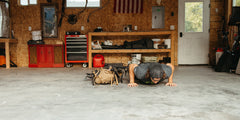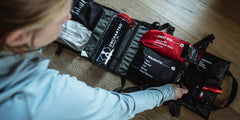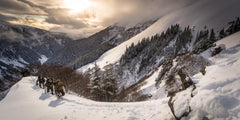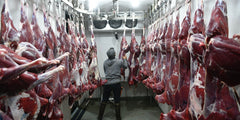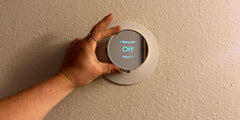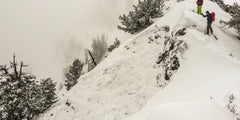
Water is a powerful compound. While all life needs water to function, it also has the ability to take life away. Before we dove into the ocean as a child, we needed to learn about the dangers of riptides, undertows, and rip currents. Likewise, we need to learn about the dangers of avalanches before we “dive” into the backcountry. Whether you’re skiing, snowboarding, snowmobiling, snowshoeing, hiking, snow-biking, or even hunting, one must learn about avalanches to safely recreate in the mountains.
So, what is the backcountry? In terms of winter, the backcountry is defined as terrain where no avalanche control work is performed. Ski areas that contain avalanche terrain mitigate avalanche problems through the use of explosives and other management techniques. Ski patrols, who are highly trained, get up early to make sure the area is safe for their patrons. But once you leave a resort boundary, you are entering the backcountry. No one is there to tell you what is safe or to come rescue you if an avalanche occurs.
Unfortunately, many victims of avalanche accidents don’t even realize they are in danger. On average, about 150 people die in avalanches each year worldwide. Even the slightest awareness of this danger can potentially save your life and, thankfully, there are many ways of getting the proper education. One such way is the Know Before You Go avalanche awareness program, and even better, it’s free of charge.
Know Before You Go is an avalanche awareness program that aims to educate the public about the dangers of avalanches. There’s not much science or fancy formulas to memorize nor is it a warning to stay out of the mountains but a way to learn about when and why avalanches occur and how to avoid getting caught in one.

As backcountry travelers we never receive positive feedback about our decisions in the mountains. It’s a wicked learning environment that only tells us when we’ve made a bad decision, making education and preparedness our best shot at avoiding being caught in an avalanche. What you don’t know can kill you when it comes to backcountry riding. The Know Before You Go program aims to get recreationalists down the right path of avalanche education while also making students aware of what they don’t know.
One of the most important things you can do each day before heading out into the backcountry is to read the local avalanche forecast. There are avalanche centers all around the world that provide updated information on avalanche conditions and mountain weather. They are there to help you make the best decisions you can to stay safe in the backcountry.

An avalanche forecast contains a ton of information. One of the most obvious pieces of information is the avalanche danger rating. In general, avalanche forecasts will describe the overall danger level for a certain area either as Low, Moderate, Considerable, High, or Extreme. Most fatalities occur when the danger is Moderate or Considerable. Understanding what the danger rating means is learned through education and experience.
An avalanche forecast will also tell you about specific avalanche problems and on what aspect and elevation they exist. Forecasts include weather information as well as videos and photos of current avalanches and observations. It is critical that you understand how to read and interpret a forecast before heading out into the backcountry. Taking a class can help you start to learn what forecasts are saying and how to apply that to your decision making so that you can avoid getting caught in an avalanche.
Avalanche forecasts are found here:
- United States - avalanche.org
- Canada - avalanche.ca
- Europe - avalanches.org
The next step in getting prepared to head into the backcountry is to make sure you have the proper rescue equipment and know how to use it. Because you are on your own in the backcountry, you must be prepared to rescue your partner should an avalanche occur. There is no one else to help you. About 25% of avalanche victims die of trauma from either the avalanche itself or hitting obstacles like rocks, trees, etc. The other 75% are buried and need your help getting out. You have about 10 minutes before the victims chances of survival start to drop quickly. Avalanche deposition sets up like concrete so it’s nearly impossible to dig yourself out. You need your partner to save you.

There are three essential pieces of avalanche rescue equipment: a transceiver, a probe, and a shovel. You must have all three to effect a successful rescue. Everyone in your group needs a transceiver - it transmits a signal but also can receive a signal once switched into “search” mode. You use the transceiver to get as close as possible to the buried victim.
![]()
You then use a probe, a long metal rod, to help you pinpoint the exact location of a buried victim and measure the burial depth. Once you get a “strike,” then you get out your metal shovel and start digging. Do not start digging until you have a definitive probe strike. You do not want to waste any energy moving heavy snow - remember, time is of the essence.

As you are digging, it is important to try to clear their airway as quickly as possible by moving snow away from the chest and head. Once you get the victim out, if they are not breathing, you should be prepared to perform rescue breathing and/or CPR. You may need to call 911 depending on the victim's condition.
Another piece of recommended equipment is an avalanche airbag. Once triggered, the airbag deploys and helps keep you on top of the avalanche. It is not guaranteed though that you’ll not get buried. They work well in the right circumstances but shouldn’t be relied on solely. Other recommended gear to carry with you includes an extra warm layer, extra gloves, a first aid kit, a repair kit, extra batteries, a headlamp, water, food, a helmet, sunscreen, an inclinometer, and a radio. In case of emergency, you might find that having one of these items helps save someone’s life.

You and your partner are each other's best chance for survival. Not getting caught in an avalanche is always the best situation but it is important to be prepared for the worst case scenario. You and everyone in your group needs a transceiver, a probe, and a shovel and must know how to use them. If an accident occurs, you want to give the buried victim the best chance of survival. An avalanche transceiver, probe, and shovel can increase these odds.
Gear can save your body, but your partner saves your life. After acquiring the essential gear, you need to get trained on how to properly use them as well as how to stay safe when traveling in the backcountry. Avalanche education is a lifelong journey, there is no such thing as too much. From avalanche classes to beacon parks, there are many ways to learn about the hazards of avalanches and what to do if your party is ever caught in one. The best method, however, is getting hands-on, face-to-face experience with an avalanche educator. Not to mention, it’s fun too.
In these classes, you’ll learn how to use avalanche rescue gear to locate your partner and save their life in the event of an emergency. You’ll get your hands in the snow and learn how to dig a snowpit to assess snow structure and stability, and how to spot bulls-eye information of rising avalanche danger as you’re traveling through the mountains.

When looking at a snow-covered peak, it’s easy to daydream about where the best powder is or which line would be the most fun to ride. With avalanche education, however, you will learn how to spot features on the slope that can tell you a whole lot about the avalanche hazard. Can you spot any recent avalanches? Is the slope exposed to the sun, or is it in the shade? Are there any wind ripples or pillows that might indicate a wind slab? Are there any terrain traps such as gullies or cliffs that an avalanche could run into?
There are a ton of visual clues that can give you insights into the avalanche hazard as you approach a particular slope. You can learn all these clues and much more as you progress through a life-long journey of avalanche education. To find an avalanche class in your area, check your regional avalanche center’s website or go to avalanche.org.

Once you get the forecast, have gotten the essential safety gear, and have started your avalanche education journey, it’s time to start putting it all together in the backcountry. A huge part of staying safe in the mountains is having the ability to apply the avalanche forecast to what you’re actively observing in the field. When dealing with any type of avalanche problem, the forecast will often mention staying off and away from slopes over 30 degrees. Being able to effectively assess slope angle in the field is critical to staying safe because avalanches typically occur on slopes between 30-45 degrees in steepness.

Carrying a slope inclinometer and studying slope-angle shading maps can help you plan a safe route in the backcountry. Additionally, avalanches often occur on convex features such as rollovers. Keeping your eyes up can help you avoid these avalanche-prone slopes and features before you get in harm’s way.
If conditions call for it and you find yourself traveling across a steep slope, there are a few safe travel protocols your group should abide by. First and foremost, spread out and only expose one person to the hazard at a time. If an avalanche does occur, it is critical to have as many people as possible to conduct a rescue. Move from safe zone to safe zone, exposing only one person at a time to a steep slope. Additionally, before you stop for a snack or water break, observe what’s above you and make sure you’re not exposed to a slope over 30 degrees.
How do we know that avalanche conditions are changing? The snowpack is always talking, and it’s our job to listen. Avalanches aren’t random acts of nature; we can usually tell when they’re about to happen. There are a few clues to look for that scream an avalanche might occur. These are known as the 5 red flags:
-
Recent Avalanches. Avalanches are a herd species, meaning if you see one, there will probably be more. When you see a recent avalanche in the field, it’s important to note what elevation and aspect it occurred on so you can avoid similar slopes. Seeing a recent avalanche in the field is free information that we can easily acquire from a safe distance. They are extremely important to take note of.

-
Cracking and Collapsing. Cracks that shoot out from under your skis or snowmobile is a clear sign that a slab is present. Remember, for an avalanche to occur there needs to be a slab, a weak layer, a slope steep enough to slide, and a trigger. Collapsing, or “whumphing”, is a little more ambiguous until you feel it while in the field. If you’re walking in a relatively untouched area of snow and feel a sudden collapse, that is actually a weak layer failing. If you’re walking on a slope steep enough to slide, this sudden collapse might be accompanied by an avalanche. These collapses often produce an audible “whumph”.

-
Wind Drifted Snow. When the wind is strong enough, it can carry snow that has already fallen into sensitive wind drifts that can easily avalanche during and after wind events. Pay attention to which direction the wind is coming as sensitive slabs of wind-drifted snow usually form on the opposite side of the compass from where it’s blowing from. For example, a strong west wind could create wind drifts on east facing slopes.

- Heavy Snowfall or Rain. With heavy snowfall comes a ton of weight being added to the snowpack in a short period of time. The snowpack needs time to adjust to its new load, and we need to wait for that time to pass. Remember, you can enjoy days like these on slopes under 30 degrees that are not connected to any avalanche terrain. Additionally, rain can quickly weaken the snowpack and cause danger to spike. However, when it’s raining in the mountains, nobody wants to be out there, so it’s an easy decision to stay home.
-
Rapidly Rising Temperatures. Quickly rising temperatures can cause the snow surface to lose cohesion, which causes the likelihood of wet avalanches to rise. As temperatures warm up, the mountains will begin showing tell-tale signs that it’s time to turn around. Rollerballs, or pinwheels, indicate that the snow surface is becoming too wet for safe travel. When we see these rollerballs, it’s time to turn around or head for shadier slopes.

Avalanches can seem a little overwhelming. But, by reading the avalanche forecast and getting the proper education, you’ll be on track to gain the experience needed to have fun while staying safe in the mountains. The KBYG program is the perfect way to start your lifelong avalanche education journey, catch a live presentation or check out the online curriculum at kbyg.org. After completing the KBYG curriculum, we encourage you to continue your education through similar awareness courses, rescue classes, level 1 avalanche courses, and safely gaining experience in the field by traveling in non-avalanche terrain.

Backcountry recreation can be a double-edged sword, but by stacking the odds in your favor you can experience all the benefits of the mountains while avoiding the tragedies. For more information on the Know Before You Go program, please visit kbyg.org or reach out to your local avalanche forecast center. We hope to see you out there safely enjoying the mountains.
